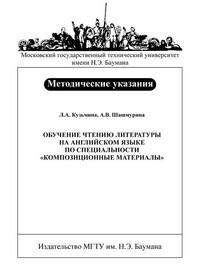Обучение чтению литературы на английском языке по специальности «Композиционные материалы»
Покупка
Тематика:
Английский язык
Год издания: 2012
Кол-во страниц: 36
Дополнительно
Вид издания:
Учебно-методическая литература
Уровень образования:
ВО - Бакалавриат
Артикул: 840508.01.99
В методических указаниях представлены оригинальные тексты на английском языке, необходимые для аудиторной и самостоятельной работы студентов, обучающихся по специальности «Композиционные материалы», а также упражнения на развитие навыков устной речи, чтения и понимания научно-технической литературы на английском языке, на закрепление грамматического и лексического материала. Для студентов старших курсов факультета «Специальное машиностроение» МГТУ им. Н.Э, Баумана. Рекомендовано Учебно-методической комиссией НУК ФН МГТУ им. Н.Э. Баумана.
Скопировать запись
Фрагмент текстового слоя документа размещен для индексирующих роботов
Московский государственный технический университет имени Н.Э. Баумана Л.А. Кузьмина, А.В. Шашмурина ОБУЧЕНИЕ ЧТЕНИЮ ЛИТЕРАТУРЫ НА АНГЛИЙСКОМ ЯЗЫКЕ ПО СПЕЦИАЛЬНОСТИ «КОМПОЗИЦИОННЫЕ МАТЕРИАЛЫ» Методические указания М о с к в а Издательство МГТУ им. Н.Э. Баумана 2 0 1 2
УДК 802.0
ББК 81.2 Англ-923
К89
Рецензент И.В. Стасенко
Кузьмина Л.А.
Обучение чтению литературы на английском языке по
специальности
«Композиционные
материалы»
:
метод.
указания / Л.А. Кузьмина, А.В. Шашмурина. — М.: Изд-во
МГТУ им. Н.Э. Баумана, 2012. — 32, [4] с.
В методических указаниях представлены оригинальные тексты
на английском языке, необходимые для аудиторной и самостоятельной работы студентов, обучающихся по специальности «Композиционные материалы», а также упражнения на развитие навыков
устной речи, чтения и понимания научно-технической литературы
на английском языке, на закрепление грамматического и лексического материала.
Для студентов старших курсов факультета «Специальное машиностроение» МГТУ им. Н.Э, Баумана.
Рекомендовано Учебно-методической комиссией НУК ФН
МГТУ им. Н.Э. Баумана.
УДК 802.0
ББК 81.2 Англ-923
© МГТУ им. Н.Э. Баумана, 2012
К89
ПРЕДИСЛОВИЕ В методических указаниях представлены оригинальные тексты, взятые из английских научно-технических изданий, необходимые для аудиторной и самостоятельной работы студентов старших курсов, обучающихся по специальности «Композиционные материалы». Методические указания состоят из трех блоков, включающих тексты для изучающего, просмотрового и поискового чтения, активную лексику, упражнения, направленные на закрепление лексико-грамматического материала. Предложены также тексты для письменного перевода как с английского языка на русский, так и с русского языка на английский, требующие последующего обсуждения трудностей перевода. Помимо этого представлены коммуникационные задания по основным проблемам, затронутым в методических указаниях. Целью работы является помощь студентам в освоении и развитии навыков чтения, перевода и коммуникации по специальности «Композиционные материалы».
UNIT I New Words and Word Combination align v — располагать по одной линии, выравнивать asset n — ценное, полезное свойство bend v — изгибать, гнуть binding power — связующая способность brittle adj — хрупкий bundle n — связка, пучок cure v — восстанавливать dissolve v — растворяться fracture toughness — вязкость разрушения, трещиностойкость irreversible adj — неизменяемый, необратимый mould n — форма, лекало, шаблон moulding process — процесс формовки pultrusion n — получение одноосноориентированного волокнистого пластика reinforcement n — усиление, упрочнение, армирование saturate v — пропитывать, насыщать share stress — распределять нагрузку snap v — разламывать stretch v — растягивать, вытягивать tailor properties — разрабатывать, проектировать свойства thermoplastic(s) — термопластмасса thermoset — реактопласт, термореактивная пластмасса thread n — нить timber n — древесина wear n — износ


